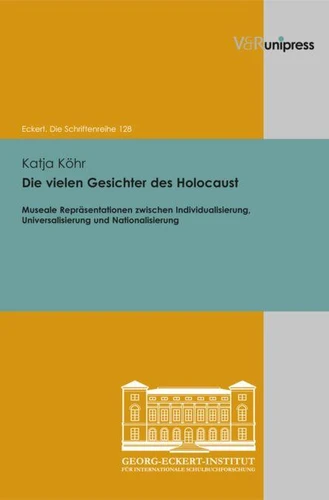Die vielen Gesichter des Holocaust. Museale Repräsentationen zwischen Individualisierung, Universalisierung und Nationalisierung
Par : ,Formats :
Disponible dans votre compte client Decitre ou Furet du Nord dès validation de votre commande. Le format PDF est :
- Compatible avec une lecture sur My Vivlio (smartphone, tablette, ordinateur)
- Compatible avec une lecture sur liseuses Vivlio
- Pour les liseuses autres que Vivlio, vous devez utiliser le logiciel Adobe Digital Edition. Non compatible avec la lecture sur les liseuses Kindle, Remarkable et Sony
 , qui est-ce ?
, qui est-ce ?Notre partenaire de plateforme de lecture numérique où vous retrouverez l'ensemble de vos ebooks gratuitement
Pour en savoir plus sur nos ebooks, consultez notre aide en ligne ici
- Nombre de pages269
- FormatPDF
- ISBN978-3-86234-671-4
- EAN9783862346714
- Date de parution24/10/2012
- Protection num.pas de protection
- Taille2 Mo
- Infos supplémentairespdf
- ÉditeurV&R Unipress
Résumé
The process of remembering the Holocaust is facing a turning point. As the last members of the generation who experienced the Holocaust die, secondary presentations of history are replacing primary narratives. Cultural history media are entrusted with an important task as part of this development. They must keep the memories alive and transfer them from a communicative memory to societies' cultural memory.
The aim of this study is to show how representations in museums react to these challenges. Transnational and national tendencies are enquired into, as are similarities and differences in representations of the Holocaust in museums. The analysis focuses on the Holocaust History Museum in Yad Vashem, the Information Center for the Memorial for the Murdered Jews of Europe in Berlin, the United States Holocaust Museum in Washington, the Holocaust Center in Oslo and the Memorial Center in Budapest.
The aim of this study is to show how representations in museums react to these challenges. Transnational and national tendencies are enquired into, as are similarities and differences in representations of the Holocaust in museums. The analysis focuses on the Holocaust History Museum in Yad Vashem, the Information Center for the Memorial for the Murdered Jews of Europe in Berlin, the United States Holocaust Museum in Washington, the Holocaust Center in Oslo and the Memorial Center in Budapest.
The process of remembering the Holocaust is facing a turning point. As the last members of the generation who experienced the Holocaust die, secondary presentations of history are replacing primary narratives. Cultural history media are entrusted with an important task as part of this development. They must keep the memories alive and transfer them from a communicative memory to societies' cultural memory.
The aim of this study is to show how representations in museums react to these challenges. Transnational and national tendencies are enquired into, as are similarities and differences in representations of the Holocaust in museums. The analysis focuses on the Holocaust History Museum in Yad Vashem, the Information Center for the Memorial for the Murdered Jews of Europe in Berlin, the United States Holocaust Museum in Washington, the Holocaust Center in Oslo and the Memorial Center in Budapest.
The aim of this study is to show how representations in museums react to these challenges. Transnational and national tendencies are enquired into, as are similarities and differences in representations of the Holocaust in museums. The analysis focuses on the Holocaust History Museum in Yad Vashem, the Information Center for the Memorial for the Murdered Jews of Europe in Berlin, the United States Holocaust Museum in Washington, the Holocaust Center in Oslo and the Memorial Center in Budapest.



